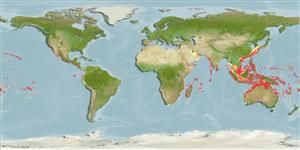Classification / Names
Common names from other countries
Main reference
Size / Weight / Age
Max length : 240 cm TL male/unsexed; (Ref. 48635)
Length at first maturity
Lm ?, range 65 - ? cm
Environment
Marine; reef-associated; depth range 1 - 150 m (Ref. 1602)
Climate / Range
Tropical, preferred ?; 35°N - 36°S, 19°E - 77°W
Distribution
Indo-Pacific: Red Sea and South Africa (Ref. 3257) eastward to the Tuamoto and Austral islands, north to the Ryukyu and Hawaiian islands, south to New Caledonia. Eastern Pacific: Costa Rica, Panama and the Galapagos (Ref. 9324). Southeast Atlantic: South Africa.
Countries | FAO areas | Ecosystems | Occurrences | Introductions
Short description
Dorsal
spines
(total): 0;
Dorsal
soft rays
(total): 0;
Anal
spines: 0;
Anal
soft rays: 0;
Vertebrae: 132 - 140. Reddish eyes (Ref. 1602). Color yellowish, densely mottled with dark brown; front of head purplish grey; posterior margins of fins yellow-green; gill opening in a black blotch. Juveniles sometimes bright yellow with brown blotches (Ref. 48635).
IUCN Red List Status (Ref. 115185)
Threat to humans
Reports of ciguatera poisoning (Ref. 4690)
Human uses
Fisheries: commercial; aquarium: commercial
More information
ReferencesAquacultureAquaculture profileStrainsGeneticsAllele frequenciesHeritabilityDiseasesProcessingMass conversion
Tools
Special reports
Download XML
Internet sources
Estimates of some properties based on models
Phylogenetic diversity index
PD50 = 0.5000 many relatives (e.g. carps) 0.5 - 2.0 few relatives (e.g. lungfishes)
Trophic Level
4.2 ±0.72 se; Based on food items.
Resilience
Very Low, minimum population doubling time more than 14 years (Preliminary K or Fecundity.)
Vulnerability
Very high vulnerability (84 of 100)
Price category
